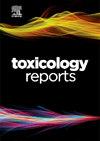Habit of elongate amphibole particles as a predictor of mesothelial carcinogenicity
Q1 Environmental Science
引用次数: 0
Abstract
Introduction
Amphiboles are a class of minerals that are abundantly present in the environment. Amphiboles may exist in several habits, with asbestiform particles behaving like typical amphibole asbestos and non-asbestiform (or massive) reported to be less biologically active.
Materials and methods
The available dimensional information for 16 testing sets (8 asbestiform and 8 non-asbestiform types of tremolite) was combined. In addition, three validation sets (an asbestiform sample from Eastern New York and non-asbestiform samples from Quebec and Falls Village, Connecticut) were tested by Transmission Electron Microscopy (TEM) to determine dimensional distribution. Mathematical modeling was utilized to determine the classification method for amphiboles with various habits.
Results
The decision boundary method was developed to distinguish asbestiform vs. non-asbestiform samples (with error rate of 0 % for single-sourced tremolite and 3 % for potentially mixed samples). All validation datasets were correctly classified. A new empirical dimensional coefficient of carcinogenicity (DCC) was proposed, with DCC = 1 - exp(-0.11 Surface Area /(1000width3 + 1)). For several mineral types (crocidolite, amosite, Libby amphiboles, anthophyllite, chrysotile, and erionite), it was demonstrated that mesothelioma potency factors can be predicted based on DCC and biosolubility with a high level of accuracy (R=0.98, R2=0.96, p < 0.006). It was demonstrated that modeled mesothelioma potency correlates with relative potency for pleural instillation in Wistar rats, and correlates inversely with membranolytic toxicity index HC50. Mesothelioma potency was demonstrated to be negligible in all non-asbestiform sets.
Conclusions
The habit of amphibole particles is predictive of biological behavior that can be estimated from the dimensional data for the particles.
长角闪孔颗粒的习性作为间皮致癌性的预测因子
角闪石是一类丰富存在于环境中的矿物。角闪石可能以多种形态存在,其中石棉颗粒的行为与典型的角闪洞石棉相似,而据报道,非石棉颗粒(或块状)的生物活性较低。材料与方法将16个测试组(8种石棉类型和8种非石棉类型)的现有尺寸信息进行组合。此外,三个验证集(来自纽约东部的石棉样品和来自魁北克和康涅狄格州福尔斯村的非石棉样品)通过透射电子显微镜(TEM)测试以确定尺寸分布。利用数学模型确定了具有不同习性的角闪石的分类方法。结果建立的决策边界法用于区分石棉和非石棉样品(单一来源透闪石的错误率为0 %,潜在混合样品的错误率为3 %)。所有验证数据集都被正确分类。提出了一个新的致癌性经验维度系数(DCC), DCC = 1 - exp(-0.11表面积/(1000width3 + 1))。对于几种矿物类型(青橄榄石、亚铁石、Libby角闪石、anthophylite、温石棉和erionite),基于DCC和生物溶解度预测间皮瘤潜能因子具有较高的准确性(R=0.98, R2=0.96, p <; 0.006)。结果表明,模型间皮瘤效力与Wistar大鼠胸膜灌注的相对效力相关,与膜溶毒性指数HC50呈负相关。间皮瘤的效力在所有非石棉组中被证明是可以忽略不计的。结论角闪孔颗粒的习性可以预测其生物行为,并可通过颗粒的尺寸数据进行估计。
本文章由计算机程序翻译,如有差异,请以英文原文为准。
求助全文
约1分钟内获得全文
求助全文
来源期刊

Toxicology Reports
Environmental Science-Health, Toxicology and Mutagenesis
CiteScore
7.60
自引率
0.00%
发文量
228
审稿时长
11 weeks
 求助内容:
求助内容: 应助结果提醒方式:
应助结果提醒方式:


